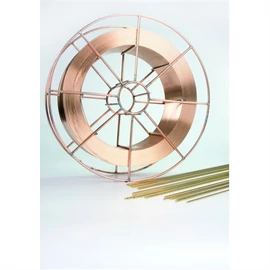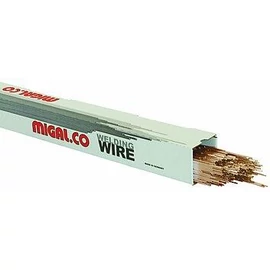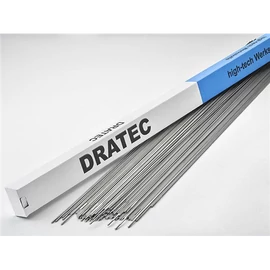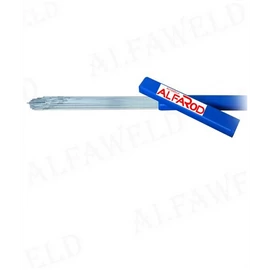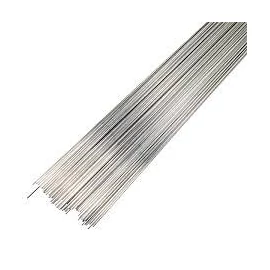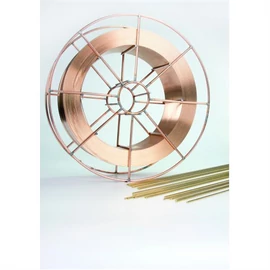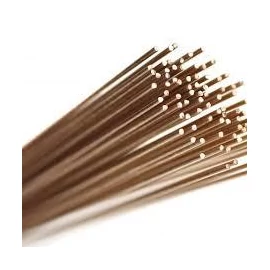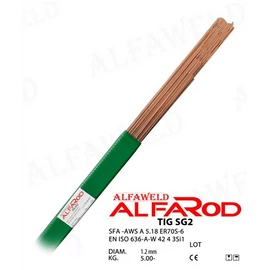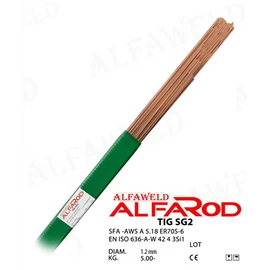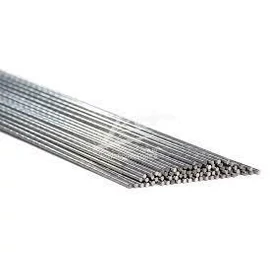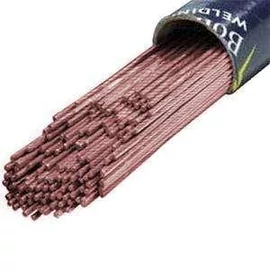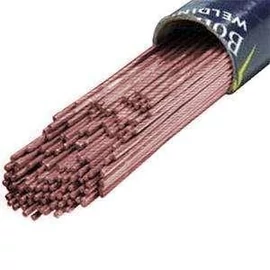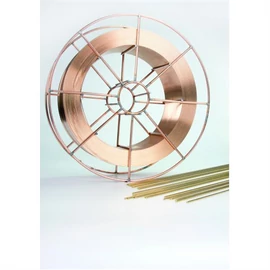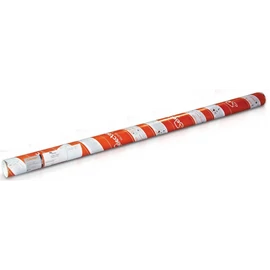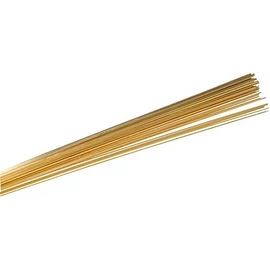AKCIÓS TERMÉKEK
TIG CuSi3 1,6x1000mm AVI hegesztőpálca-TIG rod 1461 MIGAL.CO, FSH-SELECTARC CUSIL
Ar védőgázas AVI/TIG hegesztőpálca.
Az CuSi3 összetételű huzalok a réz mellet 3% Si-t tartalmaznak így vörösréz hatású a huzal és a varrat szine.
Kis energiájú ívhegesztés hatására a horganyzott felületről a horgany nem ég le, nincs fröcskölés és rozsdamentes, ausztenites anyagok forasztása esetén is a kisebb hőbevitel miatt sokkal kissebb az alaváltozás, mint hagyományos ívhegsztés esetében.
Az autóipari, járműipar számára, főleg lemezmunkák, burkolatok tartós kötéséhez fejlesztették ki ezt az eljárást ,hogy különböző fémes anyagokat minimális fröcsköléssel, kis alakváltozással tudjanak összefrosszatni tartós mechnikai igénybevételnek egyéb környezeti hatásoknak kitéve.
Extrém esetben alumíniumot és rozsdamentes anyagot is össze lehet ezzel az eljárással hegeszteni.
Ld./ie.:
https://www.millerwelds.com/resources/article-library/silicon-bronze-mig-brazing-basics
Ideal for joining of galvanized metal sheets.
For MIG/TIG welding and weld-surfacing on low-alloyed copper alloys and on CuZn alloys.
Also for wear-resistant surfacing on low and unalloyed steel and on cast iron.
For welding of metal sheets thicker than 3,0 mm preheating to approx 250-300 °C is recommended.
For MIG weld-surfacing on big pieces preheating to approx 250 °C is recommended.
For layered weld-surfacing on ferrous base metals pulsed arc welding is recommended.
MIG brazing benefits:
MIG brazing may not be a familiar process to many, but it is no stranger in the welding world. MIG brazing is a welding process that has been around for years and is gaining popularity with professionals and hobbyists alike due to the benefits it can offer, especially with silicon bronze filler metal.
Learn about MIG brazing, silicon bronze and how to properly set up your welding power source for MIG brazing silicon bronze.
What is MIG brazing?
Brazing processes have traditionally used an oxy-fuel acetylene torch to melt the filler metal, but in MIG brazing, a standard MIG gun is used to run brazing wire. Brazing filler metal melts at 840 degrees Fahrenheit, which is lower than the melting point of the base metals being joined. Due to the lower melting point, the filler metal provides capillary action — fluid being drawn into the weld joint — when brazed.
What is silicon bronze?
Silicon bronze filler metal is mostly comprised of copper, silicon, tin, iron and zinc. The composition of the wire provides some unique benefits such as the ability to weld dissimilar metals together, reduce distortion and provide a visually appealing finish.
Welding dissimilar metals
When braze welding with silicon bronze filler metal, the molten metal bonds the base materials together but does not provide fusion like mild steel filler metal. Because of this, silicon bronze can be used for welding together dissimilar materials such as cast iron to steel or stainless steel to steel.
Main technical properties:
- Composition % (Cu – Si - Mn): Bal. - 3 - 1
- Melting range SOL - LIQ (°C): 965 - 1035
- Density (g/cm3): 8,5
- Tensile strength (kg/mm2): 35
- Standard DIN 1733: SG-CuSi3
- Standard AWS A5.7: ERCuSi-A
More information are available in the Technical Data Sheet.
ISO 24373 : S Cu 6560 (CuSi3Mn1) Material N° : 2.1461 AWS A5.7 : ERCuSi-A Description & Applications Solid wire for GMAW, especially recommended for welding of bronzes and MIG-brazing of galvanized sheets. Main applications: Automotive industry.
Top Features
·Solid wire for TIG-welding of low-alloyed copper grades
·High temperature and corrosion resistant
Typical Applications
·Copper, low alloy copper and copper-zinc alloys
Welding Positions
All
Shielding Gas
·I1 : Inert gas Ar (100%)
·I3: Inert gas Ar+ 0.5-95% He
TIG CuAl8 (Alubronz) 2,4x1000mm AVI hegesztő pálca (2.0921) MIGAL.CO
Ar védőgázas AVI/TIG hegesztőpálca.
Az CuSn6 (Ónbronz) összetételű huzalok a réz mellet 6% Sn= ónt tartalmaznak így ónbronz hatású a huzal és a varrat szine.
Kis energiájú ívhegesztés hatására a horganyzott felületről a horgany nem ég le, nincs fröcskölés és rozsdamentes, ausztenites anyagok forasztása esetén is a kisebb hőbevitel miatt sokkal kissebb az alaváltozás, mint hagyományos ívhegsztés esetében.
Az autóipari, járműipar számára, főleg lemezmunkák, burkolatok tartós kötéséhez fejlesztették ki ezt az eljárást ,hogy különböző fémes anyagokat minimális fröcsköléssel, kis alakváltozással tudjanak összefrosszatni tartós mechnikai igénybevételnek egyéb környezeti hatásoknak kitéve.
Extrém esetben alumíniumot és rozsdamentes anyagot is össze lehet ezzel az eljárással hegeszteni.
Ld./ie.:
https://www.millerwelds.com/resources/article-library/silicon-bronze-mig-brazing-basics
Ideal for joining of galvanized metal sheets.
For MIG/TIG welding and weld-surfacing on low-alloyed copper alloys and on CuZn alloys.
Also for wear-resistant surfacing on low and unalloyed steel and on cast iron.
For welding of metal sheets thicker than 3,0 mm preheating to approx 250-300 °C is recommended.
For MIG weld-surfacing on big pieces preheating to approx 250 °C is recommended.
For layered weld-surfacing on ferrous base metals pulsed arc welding is recommended.
MIG brazing benefits:
MIG brazing may not be a familiar process to many, but it is no stranger in the welding world. MIG brazing is a welding process that has been around for years and is gaining popularity with professionals and hobbyists alike due to the benefits it can offer, especially with silicon bronze filler metal.
Learn about MIG brazing, silicon bronze and how to properly set up your welding power source for MIG brazing silicon bronze.
What is MIG brazing?
Brazing processes have traditionally used an oxy-fuel acetylene torch to melt the filler metal, but in MIG brazing, a standard MIG gun is used to run brazing wire. Brazing filler metal melts at 840 degrees Fahrenheit, which is lower than the melting point of the base metals being joined. Due to the lower melting point, the filler metal provides capillary action — fluid being drawn into the weld joint — when brazed.
What is silicon bronze?
Silicon bronze filler metal is mostly comprised of copper, silicon, tin, iron and zinc. The composition of the wire provides some unique benefits such as the ability to weld dissimilar metals together, reduce distortion and provide a visually appealing finish.
Welding dissimilar metals
When braze welding with silicon bronze filler metal, the molten metal bonds the base materials together but does not provide fusion like mild steel filler metal. Because of this, silicon bronze can be used for welding together dissimilar materials such as cast iron to steel or stainless steel to steel.
Datasheet - Rod/wire electrode for Copper alloys
Typical composition in %
Al < 0,01
Zn < 0,10
Sn 4,00 - 7,00
Pb < 0,02
Fe < 0,10
P 0,01 - 0,40
Others total < 0,20
Classification
ISO 24373 S Cu 5180A (CuSn6P)
DIN 1733 SG-CuSn6
Material No. 2.1022
BS 2901 part 3 C 11
AWS A 5.7 ER CuSn - A
Base materials
CuSn4; CuSn6; CuSn8
Remarks
Filler wire for joining and surfacing of bronzes. Tough and pore-free weld metal with a controlled content of Phosphor.
Physical properties (Approx. values)
Electrical conductivity [S*m/mm²] min. 35
Heat conductivity at 20° C [W/(m*K)] 210-230
Linear heat extension coefficient (20-100°C) [1/K] 23,5 * 10-6
Physical properties (Approx. values)
Electrical conductivity [S*m/mm²] 9
Density [kg/dm³] 8,7
Solidus-Temperature [° C] 910
Liquidus-Temperature [° C] 1040
Tensile strength Rm [MPa] 320 - 360
Elongation A5 (Lo=5d0) [%] 25
Hardness [HB] 80 - 90
Welding position
PA, PB, PC, PD, PE, PF
·High temperature and corrosion resistant
Typical Applications
·Copper, low alloy copper and copper-zinc alloys
Welding Positions
All
Shielding Gas
·I1 : Inert gas Ar (100%)
·I3: Inert gas Ar+ 0.5-95% He
TIG CuAl8Ni6 (Alubronz) 3,2x1000mm AVI hegesztő pálca (2.0921) Dratec
Ar védőgázas AVI/TIG hegesztőpálca.
Az CuSn6 (Ónbronz) összetételű huzalok a réz mellet 6% Sn= ónt tartalmaznak így ónbronz hatású a huzal és a varrat szine.
Kis energiájú ívhegesztés hatására a horganyzott felületről a horgany nem ég le, nincs fröcskölés és rozsdamentes, ausztenites anyagok forasztása esetén is a kisebb hőbevitel miatt sokkal kissebb az alaváltozás, mint hagyományos ívhegsztés esetében.
Az autóipari, járműipar számára, főleg lemezmunkák, burkolatok tartós kötéséhez fejlesztették ki ezt az eljárást ,hogy különböző fémes anyagokat minimális fröcsköléssel, kis alakváltozással tudjanak összefrosszatni tartós mechnikai igénybevételnek egyéb környezeti hatásoknak kitéve.
Extrém esetben alumíniumot és rozsdamentes anyagot is össze lehet ezzel az eljárással hegeszteni.
Ld./ie.:
https://www.millerwelds.com/resources/article-library/silicon-bronze-mig-brazing-basics
Ideal for joining of galvanized metal sheets.
For MIG/TIG welding and weld-surfacing on low-alloyed copper alloys and on CuZn alloys.
Also for wear-resistant surfacing on low and unalloyed steel and on cast iron.
For welding of metal sheets thicker than 3,0 mm preheating to approx 250-300 °C is recommended.
For MIG weld-surfacing on big pieces preheating to approx 250 °C is recommended.
For layered weld-surfacing on ferrous base metals pulsed arc welding is recommended.
MIG brazing benefits:
MIG brazing may not be a familiar process to many, but it is no stranger in the welding world. MIG brazing is a welding process that has been around for years and is gaining popularity with professionals and hobbyists alike due to the benefits it can offer, especially with silicon bronze filler metal.
Learn about MIG brazing, silicon bronze and how to properly set up your welding power source for MIG brazing silicon bronze.
What is MIG brazing?
Brazing processes have traditionally used an oxy-fuel acetylene torch to melt the filler metal, but in MIG brazing, a standard MIG gun is used to run brazing wire. Brazing filler metal melts at 840 degrees Fahrenheit, which is lower than the melting point of the base metals being joined. Due to the lower melting point, the filler metal provides capillary action — fluid being drawn into the weld joint — when brazed.
What is silicon bronze?
Silicon bronze filler metal is mostly comprised of copper, silicon, tin, iron and zinc. The composition of the wire provides some unique benefits such as the ability to weld dissimilar metals together, reduce distortion and provide a visually appealing finish.
Welding dissimilar metals
When braze welding with silicon bronze filler metal, the molten metal bonds the base materials together but does not provide fusion like mild steel filler metal. Because of this, silicon bronze can be used for welding together dissimilar materials such as cast iron to steel or stainless steel to steel.
Datasheet - Rod/wire electrode for Copper alloys
Typical composition in %
Al < 0,01
Zn < 0,10
Sn 4,00 - 7,00
Pb < 0,02
Fe < 0,10
P 0,01 - 0,40
Others total < 0,20
Classification
ISO 24373 S Cu 5180A (CuSn6P)
DIN 1733 SG-CuSn6
Material No. 2.1022
BS 2901 part 3 C 11
AWS A 5.7 ER CuSn - A
Base materials
CuSn4; CuSn6; CuSn8
Remarks
Filler wire for joining and surfacing of bronzes. Tough and pore-free weld metal with a controlled content of Phosphor.
Physical properties (Approx. values)
Electrical conductivity [S*m/mm²] min. 35
Heat conductivity at 20° C [W/(m*K)] 210-230
Linear heat extension coefficient (20-100°C) [1/K] 23,5 * 10-6
Physical properties (Approx. values)
Electrical conductivity [S*m/mm²] 9
Density [kg/dm³] 8,7
Solidus-Temperature [° C] 910
Liquidus-Temperature [° C] 1040
Tensile strength Rm [MPa] 320 - 360
Elongation A5 (Lo=5d0) [%] 25
Hardness [HB] 80 - 90
Welding position
PA, PB, PC, PD, PE, PF
·High temperature and corrosion resistant
Typical Applications
·Copper, low alloy copper and copper-zinc alloys
Welding Positions
All
Shielding Gas
·I1 : Inert gas Ar (100%)
·I3: Inert gas Ar+ 0.5-95% He
TIG 308LSi (19/9 NC Si) 1,2x1000mm Alfarod pálca (5kg/cs.)
W 19 9 LSI ER 308 LSI Rp 0,2%: 400 MPa Rm: 590 MPa A5: 40% CV: 20 ° C · 120 J -196 ° C · 50 J 1,00 – 3,20 mm 1000 mm
TIG CuSn6 (Ónbronz) 2,4x1000mm AVI hegesztő pálca Dratec
Ar védőgázas AVI/TIG hegesztőpálca.
Az CuSn6 (Ónbronz) összetételű huzalok a réz mellet 6% Sn= ónt tartalmaznak így ónbronz hatású a huzal és a varrat szine.
Kis energiájú ívhegesztés hatására a horganyzott felületről a horgany nem ég le, nincs fröcskölés és rozsdamentes, ausztenites anyagok forasztása esetén is a kisebb hőbevitel miatt sokkal kissebb az alaváltozás, mint hagyományos ívhegsztés esetében.
Az autóipari, járműipar számára, főleg lemezmunkák, burkolatok tartós kötéséhez fejlesztették ki ezt az eljárást ,hogy különböző fémes anyagokat minimális fröcsköléssel, kis alakváltozással tudjanak összefrosszatni tartós mechnikai igénybevételnek egyéb környezeti hatásoknak kitéve.
Extrém esetben alumíniumot és rozsdamentes anyagot is össze lehet ezzel az eljárással hegeszteni.
Ld./ie.:
https://www.millerwelds.com/resources/article-library/silicon-bronze-mig-brazing-basics
Ideal for joining of galvanized metal sheets.
For MIG/TIG welding and weld-surfacing on low-alloyed copper alloys and on CuZn alloys.
Also for wear-resistant surfacing on low and unalloyed steel and on cast iron.
For welding of metal sheets thicker than 3,0 mm preheating to approx 250-300 °C is recommended.
For MIG weld-surfacing on big pieces preheating to approx 250 °C is recommended.
For layered weld-surfacing on ferrous base metals pulsed arc welding is recommended.
MIG brazing benefits:
MIG brazing may not be a familiar process to many, but it is no stranger in the welding world. MIG brazing is a welding process that has been around for years and is gaining popularity with professionals and hobbyists alike due to the benefits it can offer, especially with silicon bronze filler metal.
Learn about MIG brazing, silicon bronze and how to properly set up your welding power source for MIG brazing silicon bronze.
What is MIG brazing?
Brazing processes have traditionally used an oxy-fuel acetylene torch to melt the filler metal, but in MIG brazing, a standard MIG gun is used to run brazing wire. Brazing filler metal melts at 840 degrees Fahrenheit, which is lower than the melting point of the base metals being joined. Due to the lower melting point, the filler metal provides capillary action — fluid being drawn into the weld joint — when brazed.
What is silicon bronze?
Silicon bronze filler metal is mostly comprised of copper, silicon, tin, iron and zinc. The composition of the wire provides some unique benefits such as the ability to weld dissimilar metals together, reduce distortion and provide a visually appealing finish.
Welding dissimilar metals
When braze welding with silicon bronze filler metal, the molten metal bonds the base materials together but does not provide fusion like mild steel filler metal. Because of this, silicon bronze can be used for welding together dissimilar materials such as cast iron to steel or stainless steel to steel.
Datasheet - Rod/wire electrode for Copper alloys
Typical composition in %
Al < 0,01
Zn < 0,10
Sn 4,00 - 7,00
Pb < 0,02
Fe < 0,10
P 0,01 - 0,40
Others total < 0,20
Classification
ISO 24373 S Cu 5180A (CuSn6P)
DIN 1733 SG-CuSn6
Material No. 2.1022
BS 2901 part 3 C 11
AWS A 5.7 ER CuSn - A
Base materials
CuSn4; CuSn6; CuSn8
Remarks
Filler wire for joining and surfacing of bronzes. Tough and pore-free weld metal with a controlled content of Phosphor.
Physical properties (Approx. values)
Electrical conductivity [S*m/mm²] min. 35
Heat conductivity at 20° C [W/(m*K)] 210-230
Linear heat extension coefficient (20-100°C) [1/K] 23,5 * 10-6
Physical properties (Approx. values)
Electrical conductivity [S*m/mm²] 9
Density [kg/dm³] 8,7
Solidus-Temperature [° C] 910
Liquidus-Temperature [° C] 1040
Tensile strength Rm [MPa] 320 - 360
Elongation A5 (Lo=5d0) [%] 25
Hardness [HB] 80 - 90
Welding position
PA, PB, PC, PD, PE, PF
·High temperature and corrosion resistant
Typical Applications
·Copper, low alloy copper and copper-zinc alloys
Welding Positions
All
Shielding Gas
·I1 : Inert gas Ar (100%)
·I3: Inert gas Ar+ 0.5-95% He
TIG CuSn6 (Ónbronz) 2,0x1000mm AVI hegesztő pálca Dratec
Ar védőgázas AVI/TIG hegesztőpálca.
Az CuSn6 (Ónbronz) összetételű huzalok a réz mellet 6% Sn= ónt tartalmaznak így ónbronz hatású a huzal és a varrat szine.
Kis energiájú ívhegesztés hatására a horganyzott felületről a horgany nem ég le, nincs fröcskölés és rozsdamentes, ausztenites anyagok forasztása esetén is a kisebb hőbevitel miatt sokkal kissebb az alaváltozás, mint hagyományos ívhegsztés esetében.
Az autóipari, járműipar számára, főleg lemezmunkák, burkolatok tartós kötéséhez fejlesztették ki ezt az eljárást ,hogy különböző fémes anyagokat minimális fröcsköléssel, kis alakváltozással tudjanak összefrosszatni tartós mechnikai igénybevételnek egyéb környezeti hatásoknak kitéve.
Extrém esetben alumíniumot és rozsdamentes anyagot is össze lehet ezzel az eljárással hegeszteni.
Ld./ie.:
https://www.millerwelds.com/resources/article-library/silicon-bronze-mig-brazing-basics
Ideal for joining of galvanized metal sheets.
For MIG/TIG welding and weld-surfacing on low-alloyed copper alloys and on CuZn alloys.
Also for wear-resistant surfacing on low and unalloyed steel and on cast iron.
For welding of metal sheets thicker than 3,0 mm preheating to approx 250-300 °C is recommended.
For MIG weld-surfacing on big pieces preheating to approx 250 °C is recommended.
For layered weld-surfacing on ferrous base metals pulsed arc welding is recommended.
MIG brazing benefits:
MIG brazing may not be a familiar process to many, but it is no stranger in the welding world. MIG brazing is a welding process that has been around for years and is gaining popularity with professionals and hobbyists alike due to the benefits it can offer, especially with silicon bronze filler metal.
Learn about MIG brazing, silicon bronze and how to properly set up your welding power source for MIG brazing silicon bronze.
What is MIG brazing?
Brazing processes have traditionally used an oxy-fuel acetylene torch to melt the filler metal, but in MIG brazing, a standard MIG gun is used to run brazing wire. Brazing filler metal melts at 840 degrees Fahrenheit, which is lower than the melting point of the base metals being joined. Due to the lower melting point, the filler metal provides capillary action — fluid being drawn into the weld joint — when brazed.
What is silicon bronze?
Silicon bronze filler metal is mostly comprised of copper, silicon, tin, iron and zinc. The composition of the wire provides some unique benefits such as the ability to weld dissimilar metals together, reduce distortion and provide a visually appealing finish.
Welding dissimilar metals
When braze welding with silicon bronze filler metal, the molten metal bonds the base materials together but does not provide fusion like mild steel filler metal. Because of this, silicon bronze can be used for welding together dissimilar materials such as cast iron to steel or stainless steel to steel.
Datasheet - Rod/wire electrode for Copper alloys
Typical composition in %
Al < 0,01
Zn < 0,10
Sn 4,00 - 7,00
Pb < 0,02
Fe < 0,10
P 0,01 - 0,40
Others total < 0,20
Classification
ISO 24373 S Cu 5180A (CuSn6P)
DIN 1733 SG-CuSn6
Material No. 2.1022
BS 2901 part 3 C 11
AWS A 5.7 ER CuSn - A
Base materials
CuSn4; CuSn6; CuSn8
Remarks
Filler wire for joining and surfacing of bronzes. Tough and pore-free weld metal with a controlled content of Phosphor.
Physical properties (Approx. values)
Electrical conductivity [S*m/mm²] min. 35
Heat conductivity at 20° C [W/(m*K)] 210-230
Linear heat extension coefficient (20-100°C) [1/K] 23,5 * 10-6
Physical properties (Approx. values)
Electrical conductivity [S*m/mm²] 9
Density [kg/dm³] 8,7
Solidus-Temperature [° C] 910
Liquidus-Temperature [° C] 1040
Tensile strength Rm [MPa] 320 - 360
Elongation A5 (Lo=5d0) [%] 25
Hardness [HB] 80 - 90
Welding position
PA, PB, PC, PD, PE, PF
·High temperature and corrosion resistant
Typical Applications
·Copper, low alloy copper and copper-zinc alloys
Welding Positions
All
Shielding Gas
·I1 : Inert gas Ar (100%)
·I3: Inert gas Ar+ 0.5-95% He
TIG CuAg 2,0x1000mm AVI hegesztőpálca-TIG rod DRATEC DT-CuAg1 5kg/csomag (2.1211/Cu1897)
Ar védőgázas AVI/TIG hegesztőpálca.
Az CuAg összetételű huzalok a réz mellet 1% Ag-t tartalmaznak így vörösréz hatású a huzal és a varrat szine.
ISO 24373 : S Cu 1897; TIG CuAg welding rod, (CuAg1) / appr. same like UTP A38.
Kis energiájú ívhegesztés hatására a horganyzott felületről a horgany nem ég le, nincs fröcskölés és rozsdamentes, ausztenites anyagok forasztása esetén is a kisebb hőbevitel miatt sokkal kissebb az alakváltozás, mint hagyományos ívhegsztés esetében.
Az autóipari, járműipar számára, főleg lemezmunkák, burkolatok tartós kötéséhez fejlesztették ki ezt az eljárást ,hogy különböző fémes anyagokat minimális fröcsköléssel, kis alakváltozással tudjanak összefrosszatni tartós mechnikai igénybevételnek egyéb környezeti hatásoknak kitéve.
Extrém esetben alumíniumot és rozsdamentes anyagot is össze lehet ezzel az eljárással hegeszteni.
Ld./ie.:
https://www.millerwelds.com/resources/article-library/silicon-bronze-mig-brazing-basics
Ideal for joining of galvanized metal sheets.
For MIG/TIG welding and weld-surfacing on low-alloyed copper alloys and on CuZn alloys.
Also for wear-resistant surfacing on low and unalloyed steel and on cast iron.
For welding of metal sheets thicker than 3,0 mm preheating to approx 250-300 °C is recommended.
For MIG weld-surfacing on big pieces preheating to approx 250 °C is recommended.
For layered weld-surfacing on ferrous base metals pulsed arc welding is recommended.
MIG brazing benefits:
MIG brazing may not be a familiar process to many, but it is no stranger in the welding world. MIG brazing is a welding process that has been around for years and is gaining popularity with professionals and hobbyists alike due to the benefits it can offer, especially with silicon bronze filler metal.
Learn about MIG brazing, silicon bronze and how to properly set up your welding power source for MIG brazing silicon bronze.
What is MIG brazing?
Brazing processes have traditionally used an oxy-fuel acetylene torch to melt the filler metal, but in MIG brazing, a standard MIG gun is used to run brazing wire. Brazing filler metal melts at 840 degrees Fahrenheit, which is lower than the melting point of the base metals being joined. Due to the lower melting point, the filler metal provides capillary action — fluid being drawn into the weld joint — when brazed.
What is silicon bronze?
Silicon bronze filler metal is mostly comprised of copper, silicon, tin, iron and zinc. The composition of the wire provides some unique benefits such as the ability to weld dissimilar metals together, reduce distortion and provide a visually appealing finish.
Welding dissimilar metals
When braze welding with silicon bronze filler metal, the molten metal bonds the base materials together but does not provide fusion like mild steel filler metal. Because of this, silicon bronze can be used for welding together dissimilar materials such as cast iron to steel or stainless steel to steel.
Main technical properties:
- Composition % (Cu – Si - Mn): Bal. - 3 - 1
- Melting range SOL - LIQ (°C): 965 - 1035
- Density (g/cm3): 8,5
- Tensile strength (kg/mm2): 35
- Standard DIN 1733: SG-CuSi3
- Standard AWS A5.7: ERCuSi-A
More information are available in the Technical Data Sheet.
ISO 24373 : S Cu 6560 (CuAg1) Material N° : 2.1461 AWS A5.7 : ERCuSi-A Description & Applications Solid wire for GMAW, especially recommended for welding of bronzes and MIG-brazing of galvanized sheets. Main applications: Automotive industry.
Top Features
·Solid wire for TIG-welding of low-alloyed copper grades
·High temperature and corrosion resistant
Typical Applications
·Copper, low alloy copper and copper-zinc alloys
Welding Positions
All
Shielding Gas
·I1 : Inert gas Ar (100%)
·I3: Inert gas Ar+ 0.5-95% He
TIG 308LSi (19/9 NC SI) 2,0x1000mm Metalweld pálca 5kg/cs.
TIGweld308 LSI W 19 9 LSI ER 308 LSI Rp 0,2%: 400 MPa Rm: 590 MPa A5: 40% CV: 20 ° C · 120 J -196 ° C · 50 J 1,00mm – 3,20 mm 1000mm
TIG 308LSi (19/9 NC Si) 1,0x1000mm NEVINOX pálca 5kg/cs. (30810N)
W 19 9 LSI ER 308 LSI Rp 0,2%: 400 MPa Rm: 590 MPa A5: 40% CV: 20 ° C · 120 J -196 ° C · 50 J 1,00 – 3,20 mm 1000 mm
TIG SG Mo DT-SGMo (ER 80 S ISO 21952) 2,4x1000mm gyengén ötvözött AVI pálca melegszilárd acélokhoz Dratec 5kg/csomag
Elgatig 183 CR W CrMo 1 Si ER 80 S – G Re: 520 MPa Rm: 620 MPa A5: 22% CV: 20 ° C 80 J 1,60mm – 3,00 mm 1000 mm
TIG DT-2.4377 Ni4060 (NiCu30Mn3Ti) 1,6x1000mm acél-vörösréz vegyeskötéshez (minimum rendelhető 5kg.)
TIG DT-2.4377 Ni4060(NiCu30Mn3Ti)
ld. a 66. oldalon az alábbi linkről letölthető katalógusban:
https://dratec.de/wp-content/uploads/2020/08/DRATEC-Handbuch.pdf
SELECTARC TIG Ni60
ld. a 5. oldalon az alábbi linkről letölthető katalógusban:
https://www.selectarc.com/sites/default/files/2022-01/PROGRAMME_Nickel_Alloys_EN.pdf
"Monel"® típusú NiCu
Tengerészeti építmények és berendezések hegesztése tengervíz sótalanítására.
Magas hőmérsékletű és nikkelötvözetek hegesztése alkatrészgyártásban, kemencegyártásban, cementiparban. Ni190. AWS A5.11: E NiCu-7. TIG NI60
NiCu type "Monel"®
Welding of Naval constructions and installations for sea water desalination.
Welding of High temperature and nickel alloys in component manufacturing, furnace construction, cement industry. Ni190. AWS A5.11: E NiCu-7. TIG NI60
Adatlap - Hegesztőhuzalok/AVI pálcák nikkel ötvözetekhez
Tipikus összetétel %-ban
Datasheet - Welding wires/rods for Nickel alloys
Typical composition in %
Ni ≥ 62
Fe 0,5 - 2,5
C ≤ 0,15
Mn 2,0 - 4,0
Si ≤ 1,0
Cu 28 - 34
Ti 1,5 - 3,5
Al ≤ 1,0
Nb ≤ 0,5
S ≤ 0,015
P ≤ 0,02
Classification
EN ISO 18274 S Ni 4060 (NiCu30Mn3Ti)
DIN 1736 SG - NiCu30MnTi
Material No. 2.4377
AWS A 5.14 ER NiCu-7
BS 2901 NA 33
Alkalmazás:
Szilárd nikkelréz hegesztőhuzal elektróda, amely alkalmas nikkel-rézötvözetek és réz acélhoz, burkolatokhoz és pufferrétegekhez történő csatlakoztatására.
Alapanyagok:
2.4360 NiCu 30 Fe 2.4361 LC-NiCu 30 Fe 2.4365 G-NiCu Nb
2.4375 NiCu 30 Al
Application
Solid Nickel copper welding wire electrode suitable for joinig nickel copper alloys and copper to steel, claddings and buffer layers.
Base materials
Physical properties (Approx. values) at 20° C
Tensile strength Rm [MPa] 550
Yield strength Rp0,2 [MPa] 250
Elongation A200 [%] 35
Hardness [HV] 135
Specific electr. Resistance [ Ohm mm²/m] 0,62
Density [g/cm³] 8,5
Melting point [° C] 1.330
Shielding gas
MIG: Ar+1-3% O2, Ar+1-3% CO2, Ar+He+O2, Ar+He+CO2, Ar+He+CO2+H2
WIG: Ar, He, Ar+He, Ar+2-5% H2
Polarity
MIG =+, TIG =-
Welding position
PA, PB, PC, PD, PE, PF
Méretek:
MIG-huzalok [mm] 1,0; 1,2; 1,6
AVI-pálcák [mm] 1,6; 2,0; 2,4
Csomagolás:
Tekercsek csomagolási egységei:
BS 300 / 15 kg 25 orsó = 375 kg (raklap)
Dimensions
MIG-wires [mm] 1,0; 1,2; 1,6
TIG-rods [mm] 1,6; 2,0; 2,4
Packaging
Spools Packaging units
BS 300 / 15 kg 25 spools = 375 kg (Pallet)
TIG 308LSi (19/9 NC Si) 2,4x1000mm ALFAROD pálca 5kg/cs.
Cromatig 308 LSI W 19 9 LSI ER 308 LSI Rp 0,2%: 400 MPa Rm: 590 MPa A5: 40% CV: 20 ° C · 120 J -196 ° C · 50 J 1,00mm – 3,20 mm 1000mm
TIG SG2 (G3Si1) 2,0x1000mm pálca BÖHLER EML5 (EN 1668:1997: W 46 5 W2Si)
Rézzel bevont hegesztôpálca ötvözetlen és gyengén ötvözött acélok hegesztéséhez.
Az AWI pálca alkalmas vékony falu lemezekhez és csövekhez, valamint gyökhegesztéshez. Az
aránylag alacsony Si-tartalomnak köszönhetôen a hegesztôpálca különösen alkalmas olyan
hegesztett kötésekhez, melyek utólagosan zománcozásra vagy horganyzásra kerülnek. Az
AVI pálcák különösen ajánlottak gyökhegesztésre ( –50 °C-ig engedélyezve).
A BÖHLER EML 5 felhasználható kéntartalmú gázban is (HIC-vizsgálat NACE TM-02-84 szerint).
Vegyi összetétel
C Si Mn
% 0,01 0,6 1,2
Szabvány:
EN ISO 636-A: W 46 5 W2Si, EN ISO 636-B: W 55A 5U W3
Engedélyezések: TÜV-D, DB, Statoil, CE
Alapanyagok: S235J2G3 - S355J2G3, E360, P235T1-P355T1, P235G1TH, L210, L290MB, P255G1TH, P235GH, P265GH, P295GH, P310GH, P255NH, S235JRS1 - S235J4S, S355G1S - S355G3S, S255N - S385N, P255NH-P385NH, GE200-GE260, ASTM A27 u. A36 méret mind; A214; A242 méret 1-5; A266 méret 1, 2, 4; A283 méret A, B, C, D; A285 méret A, B, C; A299, méret A, B; A328; A366; A515 méret 60, 65, 70; A516 méret 55; A570 méret 30, 33, 36, 40, 45; A572 méret 42, 50; A606 méret mind; A607 méret 45; A656 méret 50, 60; A668 méret A, B; A907 Gr.30, 33, 36, 40; A841; A851 méret 1, 2; A935 méret 45; A936 méret 50; API 5 L méret B, X42 - X60
http://heginfo.hu/wp-content/uploads/hegesztoanyagok/bohler_eml_5_otvozetlen_awi_hegesztopalca.pdf
TIG SG2 (G3Si1) 3,2x1000mm pálca BÖHLER EML5 (EN 1668:1997: W 46 5 W2Si)
Rézzel bevont hegesztôpálca ötvözetlen és gyengén ötvözött acélok hegesztéséhez.
Az AWI pálca alkalmas vékony falu lemezekhez és csövekhez, valamint gyökhegesztéshez. Az
aránylag alacsony Si-tartalomnak köszönhetôen a hegesztôpálca különösen alkalmas olyan
hegesztett kötésekhez, melyek utólagosan zománcozásra vagy horganyzásra kerülnek. Az
AVI pálcák különösen ajánlottak gyökhegesztésre ( –50 °C-ig engedélyezve).
A BÖHLER EML 5 felhasználható kéntartalmú gázban is (HIC-vizsgálat NACE TM-02-84 szerint).
Vegyi összetétel
C Si Mn
% 0,01 0,6 1,2
Szabvány:
EN ISO 636-A: W 46 5 W2Si, EN ISO 636-B: W 55A 5U W3
Engedélyezések: TÜV-D, DB, Statoil, CE
Alapanyagok: S235J2G3 - S355J2G3, E360, P235T1-P355T1, P235G1TH, L210, L290MB, P255G1TH, P235GH, P265GH, P295GH, P310GH, P255NH, S235JRS1 - S235J4S, S355G1S - S355G3S, S255N - S385N, P255NH-P385NH, GE200-GE260, ASTM A27 u. A36 méret mind; A214; A242 méret 1-5; A266 méret 1, 2, 4; A283 méret A, B, C, D; A285 méret A, B, C; A299, méret A, B; A328; A366; A515 méret 60, 65, 70; A516 méret 55; A570 méret 30, 33, 36, 40, 45; A572 méret 42, 50; A606 méret mind; A607 méret 45; A656 méret 50, 60; A668 méret A, B; A907 Gr.30, 33, 36, 40; A841; A851 méret 1, 2; A935 méret 45; A936 méret 50; API 5 L méret B, X42 - X60
http://heginfo.hu/wp-content/uploads/hegesztoanyagok/bohler_eml_5_otvozetlen_awi_hegesztopalca.pdf
TIG 308LSi (19/9 NC SI) 2,0x1000mm ARC pálca 5kg/cs.
TIGweld308 LSI W 19 9 LSI ER 308 LSI Rp 0,2%: 400 MPa Rm: 590 MPa A5: 40% CV: 20 ° C · 120 J -196 ° C · 50 J 1,00mm – 3,20 mm 1000mm
TIG 308LSi (19/9 NC Si) 1,6x1000mm Elga CrInoxTIG pálca 5kg/cs. 93021016
Cromatig 308 LSI W 19 9 LSI ER 308 LSI Rp 0,2%: 400 MPa Rm: 590 MPa A5: 40% CV: 20 ° C · 120 J -196 ° C · 50 J 1,00mm – 3,20 mm x 1000mm
TIG 308LSi (19/9 NC Si) 2,0x1000mm Elga CrInoxTIG pálca 5kg/cs. 93021020
Cromatig 308 LSI W 19 9 LSI ER 308 LSI Rp 0,2%: 400 MPa Rm: 590 MPa A5: 40% CV: 20 ° C · 120 J -196 ° C · 50 J 1,00mm – 3,20 mm x 1000mm
TIG CuSi3 2,4x1000mm AVI hegesztőpálca-TIG rod (CuSi3Mn1) 1461 IW A 111 T
Ar védőgázas AVI/TIG hegesztőpálca.
Az CuSi3 összetételű huzalok a réz mellet 3% Si-t tartalmaznak így vörösréz hatású a huzal és a varrat szine.
Kis energiájú ívhegesztés hatására a horganyzott felületről a horgany nem ég le, nincs fröcskölés és rozsdamentes, ausztenites anyagok forasztása esetén is a kisebb hőbevitel miatt sokkal kissebb az alaváltozás, mint hagyományos ívhegsztés esetében.
Az autóipari, járműipar számára, főleg lemezmunkák, burkolatok tartós kötéséhez fejlesztették ki ezt az eljárást ,hogy különböző fémes anyagokat minimális fröcsköléssel, kis alakváltozással tudjanak összefrosszatni tartós mechnikai igénybevételnek egyéb környezeti hatásoknak kitéve.
Extrém esetben alumíniumot és rozsdamentes anyagot is össze lehet ezzel az eljárással hegeszteni.
Ld./ie.:
https://www.millerwelds.com/resources/article-library/silicon-bronze-mig-brazing-basics
Ideal for joining of galvanized metal sheets.
For MIG/TIG welding and weld-surfacing on low-alloyed copper alloys and on CuZn alloys.
Also for wear-resistant surfacing on low and unalloyed steel and on cast iron.
For welding of metal sheets thicker than 3,0 mm preheating to approx 250-300 °C is recommended.
For MIG weld-surfacing on big pieces preheating to approx 250 °C is recommended.
For layered weld-surfacing on ferrous base metals pulsed arc welding is recommended.
MIG brazing benefits:
MIG brazing may not be a familiar process to many, but it is no stranger in the welding world. MIG brazing is a welding process that has been around for years and is gaining popularity with professionals and hobbyists alike due to the benefits it can offer, especially with silicon bronze filler metal.
Learn about MIG brazing, silicon bronze and how to properly set up your welding power source for MIG brazing silicon bronze.
What is MIG brazing?
Brazing processes have traditionally used an oxy-fuel acetylene torch to melt the filler metal, but in MIG brazing, a standard MIG gun is used to run brazing wire. Brazing filler metal melts at 840 degrees Fahrenheit, which is lower than the melting point of the base metals being joined. Due to the lower melting point, the filler metal provides capillary action — fluid being drawn into the weld joint — when brazed.
What is silicon bronze?
Silicon bronze filler metal is mostly comprised of copper, silicon, tin, iron and zinc. The composition of the wire provides some unique benefits such as the ability to weld dissimilar metals together, reduce distortion and provide a visually appealing finish.
Welding dissimilar metals
When braze welding with silicon bronze filler metal, the molten metal bonds the base materials together but does not provide fusion like mild steel filler metal. Because of this, silicon bronze can be used for welding together dissimilar materials such as cast iron to steel or stainless steel to steel.
Main technical properties:
- Composition % (Cu – Si - Mn): Bal. - 3 - 1
- Melting range SOL - LIQ (°C): 965 - 1035
- Density (g/cm3): 8,5
- Tensile strength (kg/mm2): 35
- Standard DIN 1733: SG-CuSi3
- Standard AWS A5.7: ERCuSi-A
More information are available in the Technical Data Sheet.
ISO 24373 : S Cu 6560 (CuSi3Mn1) Material N° : 2.1461 AWS A5.7 : ERCuSi-A Description & Applications Solid wire for GMAW, especially recommended for welding of bronzes and MIG-brazing of galvanized sheets. Main applications: Automotive industry.
Top Features
·Solid wire for TIG-welding of low-alloyed copper grades
·High temperature and corrosion resistant
Typical Applications
·Copper, low alloy copper and copper-zinc alloys
Welding Positions
All
Shielding Gas
·I1 : Inert gas Ar (100%)
·I3: Inert gas Ar+ 0.5-95% He
TIG CuSn6 (Ónbronz) 2,0x1000mm AVI hegesztő pálca SELECTARC ( 2.1022 ), 5kg/csomag
Ar védőgázas AVI/TIG hegesztőpálca.
Az CuSn6 (Ónbronz) összetételű huzalok a réz mellet 6% Sn= ónt tartalmaznak így ónbronz hatású a huzal és a varrat szine.
Kis energiájú ívhegesztés hatására a horganyzott felületről a horgany nem ég le, nincs fröcskölés és rozsdamentes, ausztenites anyagok forasztása esetén is a kisebb hőbevitel miatt sokkal kissebb az alaváltozás, mint hagyományos ívhegsztés esetében.
Az autóipari, járműipar számára, főleg lemezmunkák, burkolatok tartós kötéséhez fejlesztették ki ezt az eljárást ,hogy különböző fémes anyagokat minimális fröcsköléssel, kis alakváltozással tudjanak összefrosszatni tartós mechnikai igénybevételnek egyéb környezeti hatásoknak kitéve.
Extrém esetben alumíniumot és rozsdamentes anyagot is össze lehet ezzel az eljárással hegeszteni.
Ld./ie.:
https://www.millerwelds.com/resources/article-library/silicon-bronze-mig-brazing-basics
Ideal for joining of galvanized metal sheets.
For MIG/TIG welding and weld-surfacing on low-alloyed copper alloys and on CuZn alloys.
Also for wear-resistant surfacing on low and unalloyed steel and on cast iron.
For welding of metal sheets thicker than 3,0 mm preheating to approx 250-300 °C is recommended.
For MIG weld-surfacing on big pieces preheating to approx 250 °C is recommended.
For layered weld-surfacing on ferrous base metals pulsed arc welding is recommended.
MIG brazing benefits:
MIG brazing may not be a familiar process to many, but it is no stranger in the welding world. MIG brazing is a welding process that has been around for years and is gaining popularity with professionals and hobbyists alike due to the benefits it can offer, especially with silicon bronze filler metal.
Learn about MIG brazing, silicon bronze and how to properly set up your welding power source for MIG brazing silicon bronze.
What is MIG brazing?
Brazing processes have traditionally used an oxy-fuel acetylene torch to melt the filler metal, but in MIG brazing, a standard MIG gun is used to run brazing wire. Brazing filler metal melts at 840 degrees Fahrenheit, which is lower than the melting point of the base metals being joined. Due to the lower melting point, the filler metal provides capillary action — fluid being drawn into the weld joint — when brazed.
What is silicon bronze?
Silicon bronze filler metal is mostly comprised of copper, silicon, tin, iron and zinc. The composition of the wire provides some unique benefits such as the ability to weld dissimilar metals together, reduce distortion and provide a visually appealing finish.
Welding dissimilar metals
When braze welding with silicon bronze filler metal, the molten metal bonds the base materials together but does not provide fusion like mild steel filler metal. Because of this, silicon bronze can be used for welding together dissimilar materials such as cast iron to steel or stainless steel to steel.
Datasheet - Rod/wire electrode for Copper alloys
Typical composition in %
Al < 0,01
Zn < 0,10
Sn 4,00 - 7,00
Pb < 0,02
Fe < 0,10
P 0,01 - 0,40
Others total < 0,20
Classification
ISO 24373 S Cu 5180A (CuSn6P)
DIN 1733 SG-CuSn6
Material No. 2.1022
BS 2901 part 3 C 11
AWS A 5.7 ER CuSn - A
Base materials
CuSn4; CuSn6; CuSn8
Remarks
Filler wire for joining and surfacing of bronzes. Tough and pore-free weld metal with a controlled content of Phosphor.
Physical properties (Approx. values)
Electrical conductivity [S*m/mm²] min. 35
Heat conductivity at 20° C [W/(m*K)] 210-230
Linear heat extension coefficient (20-100°C) [1/K] 23,5 * 10-6
Physical properties (Approx. values)
Electrical conductivity [S*m/mm²] 9
Density [kg/dm³] 8,7
Solidus-Temperature [° C] 910
Liquidus-Temperature [° C] 1040
Tensile strength Rm [MPa] 320 - 360
Elongation A5 (Lo=5d0) [%] 25
Hardness [HB] 80 - 90
Welding position
PA, PB, PC, PD, PE, PF
·High temperature and corrosion resistant
Typical Applications
·Copper, low alloy copper and copper-zinc alloys
Welding Positions
All
Shielding Gas
·I1 : Inert gas Ar (100%)
·I3: Inert gas Ar+ 0.5-95% He
TIG CuSn6 (Ónbronz) 2,0x1000mm AVI hegesztő pálca DT-CuSn6P,2.1022 5kg/cs. Dratec
Ar védőgázas AVI/TIG hegesztőpálca.
Az CuSn6 (Ónbronz) összetételű huzalok a réz mellet 6% Sn= ónt tartalmaznak így ónbronz hatású a huzal és a varrat szine.
Kis energiájú ívhegesztés hatására a horganyzott felületről a horgany nem ég le, nincs fröcskölés és rozsdamentes, ausztenites anyagok forasztása esetén is a kisebb hőbevitel miatt sokkal kissebb az alaváltozás, mint hagyományos ívhegsztés esetében.
Az autóipari, járműipar számára, főleg lemezmunkák, burkolatok tartós kötéséhez fejlesztették ki ezt az eljárást ,hogy különböző fémes anyagokat minimális fröcsköléssel, kis alakváltozással tudjanak összefrosszatni tartós mechnikai igénybevételnek egyéb környezeti hatásoknak kitéve.
Extrém esetben alumíniumot és rozsdamentes anyagot is össze lehet ezzel az eljárással hegeszteni.
Ld./ie.:
https://www.millerwelds.com/resources/article-library/silicon-bronze-mig-brazing-basics
Ideal for joining of galvanized metal sheets.
For MIG/TIG welding and weld-surfacing on low-alloyed copper alloys and on CuZn alloys.
Also for wear-resistant surfacing on low and unalloyed steel and on cast iron.
For welding of metal sheets thicker than 3,0 mm preheating to approx 250-300 °C is recommended.
For MIG weld-surfacing on big pieces preheating to approx 250 °C is recommended.
For layered weld-surfacing on ferrous base metals pulsed arc welding is recommended.
MIG brazing benefits:
MIG brazing may not be a familiar process to many, but it is no stranger in the welding world. MIG brazing is a welding process that has been around for years and is gaining popularity with professionals and hobbyists alike due to the benefits it can offer, especially with silicon bronze filler metal.
Learn about MIG brazing, silicon bronze and how to properly set up your welding power source for MIG brazing silicon bronze.
What is MIG brazing?
Brazing processes have traditionally used an oxy-fuel acetylene torch to melt the filler metal, but in MIG brazing, a standard MIG gun is used to run brazing wire. Brazing filler metal melts at 840 degrees Fahrenheit, which is lower than the melting point of the base metals being joined. Due to the lower melting point, the filler metal provides capillary action — fluid being drawn into the weld joint — when brazed.
What is silicon bronze?
Silicon bronze filler metal is mostly comprised of copper, silicon, tin, iron and zinc. The composition of the wire provides some unique benefits such as the ability to weld dissimilar metals together, reduce distortion and provide a visually appealing finish.
Welding dissimilar metals
When braze welding with silicon bronze filler metal, the molten metal bonds the base materials together but does not provide fusion like mild steel filler metal. Because of this, silicon bronze can be used for welding together dissimilar materials such as cast iron to steel or stainless steel to steel.
Datasheet - Rod/wire electrode for Copper alloys
Typical composition in %
Al < 0,01
Zn < 0,10
Sn 4,00 - 7,00
Pb < 0,02
Fe < 0,10
P 0,01 - 0,40
Others total < 0,20
Classification
ISO 24373 S Cu 5180A (CuSn6P)
DIN 1733 SG-CuSn6
Material No. 2.1022
BS 2901 part 3 C 11
AWS A 5.7 ER CuSn - A
Base materials
CuSn4; CuSn6; CuSn8
Remarks
Filler wire for joining and surfacing of bronzes. Tough and pore-free weld metal with a controlled content of Phosphor.
Physical properties (Approx. values)
Electrical conductivity [S*m/mm²] min. 35
Heat conductivity at 20° C [W/(m*K)] 210-230
Linear heat extension coefficient (20-100°C) [1/K] 23,5 * 10-6
Physical properties (Approx. values)
Electrical conductivity [S*m/mm²] 9
Density [kg/dm³] 8,7
Solidus-Temperature [° C] 910
Liquidus-Temperature [° C] 1040
Tensile strength Rm [MPa] 320 - 360
Elongation A5 (Lo=5d0) [%] 25
Hardness [HB] 80 - 90
Welding position
PA, PB, PC, PD, PE, PF
·High temperature and corrosion resistant
Typical Applications
·Copper, low alloy copper and copper-zinc alloys
Welding Positions
All
Shielding Gas
·I1 : Inert gas Ar (100%)
·I3: Inert gas Ar+ 0.5-95% He
TIG CuSi3 2,0x1000mm AVI hegesztőpálca-TIG rod 1461 FSH-SELECTARC CUSIL 5kg/csomag
Ar védőgázas AVI/TIG hegesztőpálca.
Az CuSi3 összetételű huzalok a réz mellet 3% Si-t tartalmaznak így vörösréz hatású a huzal és a varrat színe.
Kis energiájú ívhegesztés hatására a horganyzott felületről a horgany nem ég le, nincs fröcskölés és rozsdamentes, ausztenites anyagok forrasztása esetén is a kisebb hőbevitel miatt sokkal kisebb az alakváltozás, mint hagyományos ívhegesztés esetében.
Az autóipari, járműipar számára, főleg lemezmunkák, burkolatok tartós kötéséhez fejlesztették ki ezt az eljárást ,hogy különböző fémes anyagokat minimális fröcsköléssel, kis alakváltozással tudjanak összeforrasztani tartós mechanikai igénybevételnek egyéb környezeti hatásoknak kitéve.
Extrém esetben alumíniumot és rozsdamentes anyagot is össze lehet ezzel az eljárással hegeszteni.
Ld./ie.:
https://www.millerwelds.com/resources/article-library/silicon-bronze-mig-brazing-basics
Ideal for joining of galvanized metal sheets.
For MIG/TIG welding and weld-surfacing on low-alloyed copper alloys and on CuZn alloys.
Also for wear-resistant surfacing on low and unalloyed steel and on cast iron.
For welding of metal sheets thicker than 3,0 mm preheating to approx 250-300 °C is recommended.
For MIG weld-surfacing on big pieces preheating to approx 250 °C is recommended.
For layered weld-surfacing on ferrous base metals pulsed arc welding is recommended.
MIG brazing benefits:
MIG brazing may not be a familiar process to many, but it is no stranger in the welding world. MIG brazing is a welding process that has been around for years and is gaining popularity with professionals and hobbyists alike due to the benefits it can offer, especially with silicon bronze filler metal.
Learn about MIG brazing, silicon bronze and how to properly set up your welding power source for MIG brazing silicon bronze.
What is MIG brazing?
Brazing processes have traditionally used an oxy-fuel acetylene torch to melt the filler metal, but in MIG brazing, a standard MIG gun is used to run brazing wire. Brazing filler metal melts at 840 degrees Fahrenheit, which is lower than the melting point of the base metals being joined. Due to the lower melting point, the filler metal provides capillary action — fluid being drawn into the weld joint — when brazed.
What is silicon bronze?
Silicon bronze filler metal is mostly comprised of copper, silicon, tin, iron and zinc. The composition of the wire provides some unique benefits such as the ability to weld dissimilar metals together, reduce distortion and provide a visually appealing finish.
Welding dissimilar metals
When braze welding with silicon bronze filler metal, the molten metal bonds the base materials together but does not provide fusion like mild steel filler metal. Because of this, silicon bronze can be used for welding together dissimilar materials such as cast iron to steel or stainless steel to steel.
Main technical properties:
- Composition % (Cu – Si - Mn): Bal. - 3 - 1
- Melting range SOL - LIQ (°C): 965 - 1035
- Density (g/cm3): 8,5
- Tensile strength (kg/mm2): 35
- Standard DIN 1733: SG-CuSi3
- Standard AWS A5.7: ERCuSi-A
More information are available in the Technical Data Sheet.
ISO 24373 : S Cu 6560 (CuSi3Mn1) Material N° : 2.1461 AWS A5.7 : ERCuSi-A Description & Applications Solid wire for GMAW, especially recommended for welding of bronzes and MIG-brazing of galvanized sheets. Main applications: Automotive industry.
Top Features
·Solid wire for TIG-welding of low-alloyed copper grades
·High temperature and corrosion resistant
Typical Applications
·Copper, low alloy copper and copper-zinc alloys
Welding Positions
All
Shielding Gas
·I1 : Inert gas Ar (100%)
·I3: Inert gas Ar+ 0.5-95% He

